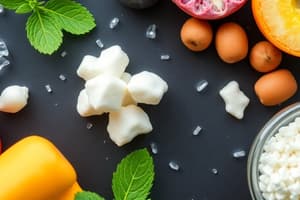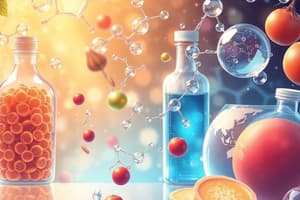Podcast
Questions and Answers
What are the main uses of carbohydrates?
What are the main uses of carbohydrates?
- Structural components and synthesis of proteins
- Source of energy and synthesis of lipids
- Synthesis of lipids and storage of water
- Source of energy and structural components (correct)
What is the molar ratio of carbohydrates in terms of carbon, hydrogen, and oxygen?
What is the molar ratio of carbohydrates in terms of carbon, hydrogen, and oxygen?
- CH4O2
- C3H6O3
- C2H4O2
- C1H2O1 (correct)
Which type of carbohydrate can be categorized as a simple building block?
Which type of carbohydrate can be categorized as a simple building block?
- Oligosaccharides
- Monosaccharides (correct)
- Polysaccharides
- Disaccharides
What determines how two sugars interact when forming a bond in disaccharides?
What determines how two sugars interact when forming a bond in disaccharides?
What type of bond is formed between the anomeric carbon of maltose?
What type of bond is formed between the anomeric carbon of maltose?
Which group attacks the aldehyde group to form an intramolecular hemiacetal group in the formation of cyclic glucose?
Which group attacks the aldehyde group to form an intramolecular hemiacetal group in the formation of cyclic glucose?
In which position does the OH group point when the alcohol group attacks the aldehyde from the top in the formation of cyclic glucose?
In which position does the OH group point when the alcohol group attacks the aldehyde from the top in the formation of cyclic glucose?
What is the main property of enantiomers?
What is the main property of enantiomers?
How can D glucose be identified based on its penultimate carbon?
How can D glucose be identified based on its penultimate carbon?
Which test is used to detect reducing sugars like glucose in a sample?
Which test is used to detect reducing sugars like glucose in a sample?
What color does starch turn when iodine is added to it?
What color does starch turn when iodine is added to it?
What type of glycosylation occurs on amino acids serine and threonine?
What type of glycosylation occurs on amino acids serine and threonine?
What is the composition of starch?
What is the composition of starch?
What type of linkage does cellulose have between glucose units?
What type of linkage does cellulose have between glucose units?
Which type of bond does glycogen have at its branching points?
Which type of bond does glycogen have at its branching points?
Which type of test is used to detect for the presence of starch?
Which type of test is used to detect for the presence of starch?
What is the result of the alcohol group attacking the aldehyde from the top in the formation of cyclic glucose?
What is the result of the alcohol group attacking the aldehyde from the top in the formation of cyclic glucose?
What is the composition of starch?
What is the composition of starch?
Which type of glycosylation occurs on amino acids serine and threonine?
Which type of glycosylation occurs on amino acids serine and threonine?
What is the main property of enantiomers?
What is the main property of enantiomers?
What determines how two sugars interact when forming a bond in disaccharides?
What determines how two sugars interact when forming a bond in disaccharides?
What color does starch turn when iodine is added to it?
What color does starch turn when iodine is added to it?
What type of bond does glycogen have at its branching points?
What type of bond does glycogen have at its branching points?
Which test is used to detect reducing sugars like glucose in a sample?
Which test is used to detect reducing sugars like glucose in a sample?
In which position does the OH group point when the alcohol group attacks the aldehyde from the back in the formation of cyclic glucose?
In which position does the OH group point when the alcohol group attacks the aldehyde from the back in the formation of cyclic glucose?
What type of linkage does cellulose have between glucose units?
What type of linkage does cellulose have between glucose units?
Why are disaccharide bond types drawn differently?
Why are disaccharide bond types drawn differently?
What determines the labeling of carbons in hexoses?
What determines the labeling of carbons in hexoses?
What dictates how two sugars interact when forming a bond in disaccharides?
What dictates how two sugars interact when forming a bond in disaccharides?
In which form can any carbohydrate exist?
In which form can any carbohydrate exist?
What type of bond does glycogen have at its branching points?
What type of bond does glycogen have at its branching points?
What are the main uses of carbohydrates?
What are the main uses of carbohydrates?
which form of carbohydrates is favoured?
which form of carbohydrates is favoured?
Flashcards are hidden until you start studying
Study Notes
Carbohydrate Properties and Structure
- Carbohydrates have various uses, including providing energy, forming structures, and serving as markers for cell recognition.
- The general molar ratio of carbohydrates is CH2O, with varying Carbon:Hydrogen:Oxygen ratios depending on the specific carbohydrate.
Simple Carbohydrate Building Blocks
- Monosaccharides, such as glucose, are simple building blocks of carbohydrates.
Disaccharide Formation
- The type of bond formed between the anomeric carbon of maltose is an α-1,4-glycosidic bond.
- The orientation of the OH group determines how two sugars interact when forming a bond in disaccharides.
Cyclic Glucose Formation
- In the formation of cyclic glucose, the hydroxymethyl group attacks the aldehyde from the top, resulting in a hemiacetal ring.
- The OH group points downwards when the alcohol group attacks the aldehyde from the top.
Properties of Enantiomers
- Enantiomers have the main property of being non-superimposable mirror images of each other.
Identifying D-Glucose
- D-glucose can be identified based on its penultimate carbon.
Detecting Reducing Sugars
- The Benedict's test is used to detect reducing sugars like glucose in a sample.
Starch Properties
- Starch turns blue-black when iodine is added to it.
- Starch is composed of long chains of α-glucose units linked by α-1,4-glycosidic bonds.
Glycosylation
- O-glycosylation occurs on amino acids serine and threonine.
Cellulose and Glycogen Structure
- Cellulose has β-1,4-glycosidic linkages between glucose units.
- Glycogen has α-1,4-glycosidic linkages between glucose units, with α-1,6-glycosidic bonds at its branching points.
Detecting Starch and Glycogen
- Iodine test is used to detect the presence of starch.
Studying That Suits You
Use AI to generate personalized quizzes and flashcards to suit your learning preferences.




